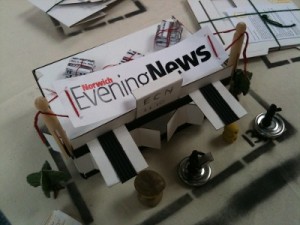I’m off to Greenbelt Festival at the weekend, and this year I’m on the team creating a print newspaper for the festival.
I blogged last year (when I was just starting out here) about the newspaper they gave out at the festival – a 16-page freesheet called While We Were Here, made possible only at the last minute with sponsorship from Hewlett Packard. It used content that was already online, sourcing images from Flickr and text from blog posts, in a neat reversal of the print-first view you (still, sadly) often see in traditional newsrooms, and it was available for download for free online as well as handed out on-site. It was – is – a wonderful souvenir of the festival, as well as being an excellent way to convey the intangible experiences of the festival. Because it was created by people right in the thick of things, writing from-the-heart blog posts/I-pieces and not carefully detached articles of traditional journalism, it does a much better job of conveying the atmosphere of the weekend than any events listing or simple description could.
Since reading and enjoying While We Were Here last year, I’ve had some experience creating newspapers from scratch on my own. I made a miniature four-page newspaper as part of a performance/installation/community experiment called Home Sweet Home by theatre company Subject to Change, consisting of a tiny cardboard suburb where people from Norwich built their own mini houses, flats and businesses, using the community billboard, radio station and postman to create stories. I built a tiny Evening News newspaper office complete with tiny clay journalists and mini bundles of newspapers, and I ran a breaking news service (on a billboard made of card and matchsticks) for three days.
The paper itself was a four-hour job in InDesign using the Evening News print templates and masthead to create something faithful to the design of the paper I was representing. The stories were a more complicated proposition. Some folks volunteered bizarre tales and information themselves in letters; others created things I found fascinating, so I wrote letters asking for more information. Many stories came from the community noticeboard, which became an outlet for frustrations and campaigns as well as plenty of advertising. It was important to create a souvenir, something tangible people could take away, and to give people who hadn’t been there a flavour of the absurdity of the event – and part of that was treating very silly stories with the seriousness I would if they were real. The skills you need to gather stories in tiny cardboard towns are, it seems, the same as you need in big concrete cities – sharp eyes, a willingness and ability to engage and converse, the ability to go where people are talking and listen to what they say.
That experiment taught me a great deal about what’s important in newsgathering. I hope the weekend’s antics will teach me something new about storytelling. Greenbelt is an entirely different proposition to Home Sweet Home – many thousands more people and much less clear avenues for newsgathering, for a start, plus the fact that the newspaper is likely to be focussed once again on individual and collective experience rather than hard news. (Though if Peter Tatchell’s talk gets really controversial, that could conceivably change.) Although I haven’t yet had a detailed brief from project leader James Stewart – and I’m not expecting one till I get there – I suspect the paper this year will once again function primarily as a record of the experience of being there – and that means a different set of challenges to what I do every day. I’m looking forward to helping to make it happen.

